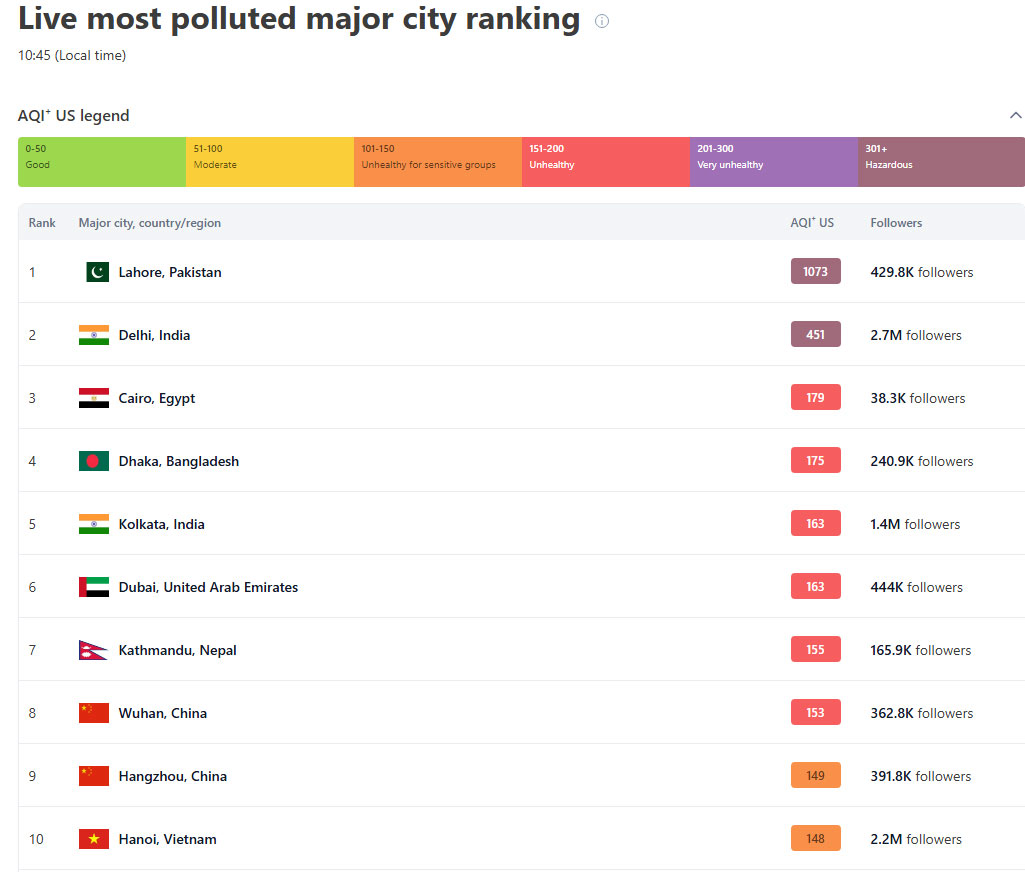
- Smog reduces visibility to zero in Lahore.
- The environmental expert advises wearing a mask and staying hydrated.
- The weather will remain dry in most parts of Punjab.
Residents of Lahore continued to struggle with ‘severe’ air quality as the Punjab capital’s air quality index crossed 1,000 again on Sunday, making it the most polluted city in the world.
According to the Swiss air quality monitor, IQAir, the level of deadly PM2.5 pollutants – the fine particles in the air that cause the most damage to health – peaked at 613, 122.6 times higher than the level considered unhealthy by the world. health organization,
Meanwhile, the Air Quality Index (AQI), which measures a range of pollutants, rose to 1,073 – even higher than yesterday’s “unprecedented” figure of 1,067 – and a real-time list of the world’s most polluted cities showed.
Thick smog shrouding the metropolis also reduced visibility to zero as the Punjab government failed to bring down pollution levels.

An environmental expert reiterated advice to citizens to avoid leaving their homes without masks, and to maintain body moisture, in addition to washing the face at short intervals.
For days, the city of 14 million has been affected by a combination of smog, pollutants from low-quality diesel fumes, smoke from seasonal agricultural fires and cold temperatures.
The city struggles with smog every year in the winter. Burning of seasonal crops by farmers on the outskirts of Lahore also contributes to air pollution, which, according to the World Health Organization, can cause strokes, heart disease and lung cancer besides respiratory diseases.
Smog caused by pollution in the city causes serious problems for residents, especially those who work outdoors. Citizens toiling in the polluted air reported difficulty breathing, coughing and burning eyes, affecting their health and productivity.
The Punjab government is striving to reduce pollution through multiple measures and has renewed smog alert, warning citizens of the harmful effects of continued poor air quality on health.
To combat smog, authorities imposed a “green lockdown” in the most polluted areas of Lahore, completely banning construction activities, entry of “Chingki auto-rickshaws”, operation of commercial generators, and opening of cooking points and food outlets using coal. Coal or wood without installing a proper emission control system.
The government also imposed mandatory mask-wearing and restricted outdoor activities, including school assemblies and playtime, to keep citizens safe from severe smog.
On the other hand, the Transport Department continues its crackdown on vehicles causing environmental pollution.
However, the measures appear to be ineffective in mitigating the impact of smog as it continues to rise across Punjab, causing a sharp deterioration in air quality.
Harmful smog also engulfed the central and southern regions of the province.
Multan, Sialkot, Narowal, Gujranwala, Sheikhupura, Jhang, Bahawalpur and Dera Ghazi Khan will witness smog, with mainly dry weather in most areas of Punjab, the Pakistan Meteorological Department (PMD) said.
Weather experts say that smoky air coming from the neighboring Indian capital, New Delhi, has contributed to the increase in smog levels.
Delhi is also suffering from increasing smog, as it is often considered the second most polluted city on IQAir’s list. It also maintained its position today as the Al-Qaeda in Iraq index reached 511 at around 10 am.
India has called for regional cooperation and cooperation in South Asia to address the deteriorating air pollution dilemma after Punjab Chief Minister Maryam Nawaz floated the idea of engaging in diplomatic efforts with India.
